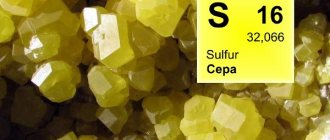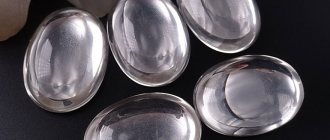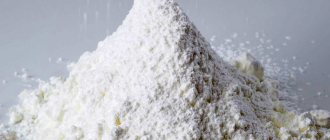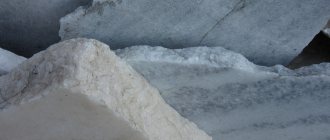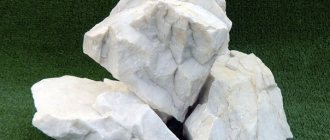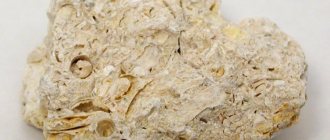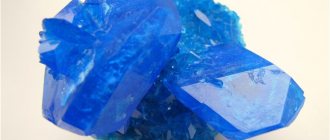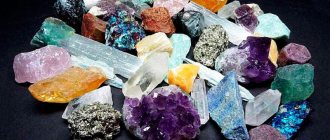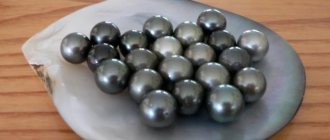Anhydrite is a sulfate class mineral that has an almost identical chemical composition to gypsum. The difference between the two rocks is that anhydrite contains no water. If a stone is placed in water, it will increase in mass by 30% and turn into gypsum. When the moisture completely evaporates, the mineral again transforms into anhydrite.
In 1804, the mineral was examined and described by the German scientist A. Werner. He gave the anhydrite its name, which is translated from ancient Greek as “deprived of water”, “dehydrated”.
Physicochemical characteristics
Anhydrite is a chemical compound of sulfur trioxide and calcium oxide. Strontium, barium and organic substances are often present as impurities.
| Index | Characteristic |
| Formula | CaSO4 |
| Mohs hardness | 3-3.5 units |
| Density | up to 3.0 g/cm³ |
| Color | White, grey, blue, pink, red, purple, violet |
| Shine | glass with mother-of-pearl tint, bold |
| Kink | uneven, conchoidal |
| Cleavage | perfect |
| Transparency | from completely transparent to opaque |
| Pleochroism effect | colorless, violet tint |
The mineral has an external similarity to marble, magnesite, dolomite, and limestone. The difference is that anhydrite, ground into powder, completely dissolves in hydrochloric acid.
What is anhydrite
Anhydrite is a mineral of sedimentary origin, actually a dehydrated form of gypsum.
In nature it is represented by crystals or agglomerates:
- Most are opaque or translucent.
- The usual color is gray, gray-blue, gray-pink, grayish with brown or reddish hues. There are red and gray-violet specimens.
- It looks almost like marble, which gives rise to misunderstandings or falsifications. For example, Zhiguli / Bergamo marble are calcium rocks with anhydrite in their composition. They can be distinguished by texture and density.
Water turns anhydrite deposits into gypsum deposits. In this case, the rock swells by one and a half times. The reverse process - dehydration - leads to the “drying out” of the layers and the appearance of underground cavities - caverns and karsts. It is no coincidence that anhydrite is called karstenite.
Origin and places of extraction
Anhydrite is a sedimentary rock that forms in drying salt water basins and rock mineral deposits rich in brass. Anhydrite is almost always found in close proximity to gypsum. Layers of the mineral that come to the surface and are exposed to moisture will also transform into gypsum over time.
Anhydrite is sometimes found in areas where volcanic lavas and hydrothermal vents pass through.
Significant anhydrite deposits are located in:
- Germany (Hannover, South Herz);
- Mexico – large specimens of anhydrite are mined;
- Russia (Orenburg, Perm and Saratov regions, Ural, Taimyr Peninsula);
- The Alpine mountains of Italy and Switzerland are rich in large druses and purple-violet aggregates;
- Peru - gems of delicate heavenly shades called angelites are mined;
- the surroundings of Lake Ontario in Canada are famous for their purple-violet stones;
- Iran (Qeshm and Hormuz Islands) – offers rare pink and purple-red specimens;
- Ukraine (Artemovsk, Slavyansk);
- Austria;
- England.
Place of Birth
The strata occur on all continents among volcanic and sedimentary rocks.
Raw materials from some deposits are easy to distinguish from others:
- The Pennine Alps (Switzerland, Italy) are the source of giant druses, clusters of bright violet-purple hues.
- Mining of large crystals is established in Mexico.
- Peruvian anhydrites the color of the spring sky were called angelites.
- Iran supplies specimens in shades of tea rose plus fiery red.
- The pride of Canada is pinkish-purple stones suitable for cutting.
In Russia, the stone is mined in Taimyr, the Perm region, the Saratov region, and the Orenburg region.
Therapeutic effect
One of the main healing properties of anhydrite is its healing effect.
The stone strengthens the immune system, increases resistance to infections, and promotes speedy recovery after operations and severe illnesses. Anhydrite helps overcome toothache and headaches. To do this, people who often suffer from these unpleasant sensations should wear earrings with a stone. Those who are concerned about problems with the digestive system are recommended to wear a ring with a mineral, and for diseases of the respiratory system, wear a pendant or pendant.
The mineral helps improve memory, makes a person more attentive and concentrated. To do this, it is enough to carry anhydrite with you.
If you infuse the stone in water and then drink a glass of healing liquid every day, you can cleanse the body of toxins. Massage using stones helps normalize hormonal levels.
Therapeutic effect
Lithotherapists have established the range of effects of the mineral:
- Relieves migraine, headache, toothache, fever.
- Protects from gastrointestinal problems.
- Helps with diseases of the thyroid gland and bronchopulmonary.
To enhance the healing effect, jewelry worn closer to the sore spot is suitable.
Magic of stone
Despite the many beneficial properties of anhydrite, esotericists do not recommend keeping the stone with you at all times. The mineral will protect its owner from troubles, give confidence and courage, but with constant contact it will reduce determination and encourage complete inaction.
By turning to the power of the stone periodically, you can get effective help. Anhydrite will add bright colors to the relationship between lovers, and for a baby it will become a powerful amulet against external negativity.
A raw stone will attract luck and fortune, while animal figurines will bring success in building a career.
By looking at the stone, you can improve your psycho-emotional state - relieve nervousness, find spiritual harmony, get rid of anxiety and fears.
Application
Anhydrite is common in many areas:
- Jewelry craftsmanship. Due to its increased fragility, not all types of jewelry are made from the mineral. Rings, bracelets and other types of products subject to mechanical stress are not made from anhydrite. Inserts into brooches and earrings, beads, and pendants are made mainly in single copies by hand-made craftsmen.
- Collecting. Unusual druses and intergrowths are prized by collectors. Of particular note are specimens of blue and red hue, intergrown with halite, dolomite, gypsum or calcite.
- Decor. A wide range of crafts, souvenirs and decorative elements are made from the mineral - balls, pyramids, eggs, animal figurines, writing instruments, boxes, ashtrays, etc.
- Finishing. Massive anhydrite druses are used to make facing tiles and mosaics.
- Other industries. In agriculture, the mineral is used to neutralize salts in the soil. Anhydrite is also used as a sulfur raw material.
Where is it used?
The mineral has found application depending on its characteristics.
Industry
Ordinary raw materials are used by industry and the agro-industrial complex:
- As a source for the production of sulfuric acid.
- Cement for the construction complex.
- A product that reduces soil salinity.
Almost all volumes of extracted raw materials are used for these purposes.
Other areas
The most beautiful stones are intended for jewelers. They create cabochons and facet jewelry inserts.
Stone cutters carve figurines, balls, and interior items.
Stone is not used for external decoration, only in interiors.
Large transparent crystals, specimens of rare colors and shades are of particular importance for collectors of mineralogical collections.
Price
The price of anhydrite products depends on the deposit of the stone and its size. For example, beads up to 14 mm in size can be purchased for $0.3-1.4 per piece. Products with this mineral are a little more expensive: $20 – pendant in silver; $40-45 – silver ring; $80 – souvenir ball with a diameter of 65 mm.
The cost of jewelry made in single copies and carved items is several times higher. Thus, the price for carved figurines of animals up to 300 mm high can reach $850-900.
How to care?
To preserve the integrity of anhydrite, you should adhere to certain rules in storage and care:
- Do not allow the mineral to come into contact with moisture. As soon as water hits the surface of anhydrite, it will immediately turn into gypsum. To prevent this from happening, it is not recommended to wear jewelry with a gem in the pool, on the beach, before taking a bath, or in rainy weather. You should also not allow anhydrite to touch bare areas of the body, so that sweat particles are not absorbed into it.
- Anhydrite is very fragile, so it must be protected from any mechanical stress.
- To clean the mineral, use a soft, dry brush or cloth. Cleaning with water, abrasives and chemicals is prohibited.
- It is recommended to store the stone in a separate box with a tight-fitting lid away in a dry place.
How to distinguish from a fake
The beneficial healing and magical properties of anhydrite appear only if it is of natural origin. Unfortunately, on store shelves quite often, instead of a real mineral, you can find a cheap fake made of plastic. You can identify a fake by several signs:
- Real anhydrite has a lower hardness rating than plastic.
- If anhydrite is placed in water, it will increase in volume and transform into gypsum.
- Real stone has a rough surface, and inclusions of organic origin and other rocks can be seen in the structure. Moreover, the surface almost always has defects in the form of cracks and chips.
- Anhydrite has an uneven color, but the pattern is always original.
Plastic is also distinguished from natural stone by its lower specific gravity and high thermal conductivity. Real anhydrite stays cooler longer when squeezed in the palm of your hand than synthetic material.
Anhydrides are derivatives of carboxylic acids in which the hydrogen atom of the carboxyl group is replaced by an acyl group.
Classification. Nomenclature
Anhydrides are products of dehydration of carboxylic acids. There are linear and cyclic anhydrides of carboxylic acids:
Linear anhydrides, the molecule of which contains residues of various acids, including mineral ones, are called mixed anhydrides.
The names of anhydrides are formed from the trivial names of the corresponding acids:
Methods of obtaining
1. Dehydration of carboxylic acids
Linear anhydrides can be obtained from carboxylic acids by reacting with strong water-removing reagents (P2O5, trifluoroacetic anhydride C4F6O3). Cyclic anhydrides are obtained by eliminating water from dicarboxylic acids when heated:
2. Interaction of acid halides with salts of carboxylic acids
Linear anhydrides are obtained by reacting acid chlorides with sodium or potassium salts of carboxylic acids:
3. Interaction of carboxylic acids with ketenes
Anhydrides are obtained by reacting carboxylic acids with ketenes:
This method is used industrially to obtain acetic anhydride.
The first representative of the homologous series, formic acid anhydride, is unstable .
Physical properties
Carboxylic acid anhydrides are colorless liquids or crystalline substances. The lower representatives of the homologous series have an irritating odor. Carboxylic acid anhydrides are slightly soluble in water and react slowly with it.
Characteristics of reactivity
Carboxylic acid anhydrides, like acid halides, are very active electrophilic reagents. The bonds in the molecules of carboxylic acid anhydrides are highly polarized.
Anhydrides of carboxylic acids have a less pronounced electrophilic character than acid halides, but exhibit greater electrophilicity compared to carboxylic acids, since their oxygen atom, which exhibits the +M effect, belongs to two acyl groups:
Carboxylic acid anhydrides easily react with various nucleophilic reagents and are used to introduce acyl groups into their structure.
Chemical properties
1. Interaction with water (hydrolysis)
When interacting with water, anhydrides slowly hydrolyze to form the corresponding acids:
2. Interaction with ammonia (ammonolysis)
When linear anhydrides react with ammonia, primary or secondary amines, carboxylic acid amides are formed:
Cyclic anhydrides react with ammonia and primary amines to form partial amides of dicarboxylic acids, which, when heated, cyclize into imides:
3. Interaction with alcohols (alcoholyses)
When linear anhydrides are treated with alcohols, esters are formed:
Cyclic anhydrides react with alcohols to form partial (acidic) esters of dicarboxylic acids:
4. Reactions of the α -hydrogen atom
As in the case of carboxylic acids, in anhydride molecules the hydrogen atoms at the α-carbon atoms are mobile. With the participation of the CH bond in the α-position, carboxylic acid anhydrides in the presence of bases (salts of carboxylic acids, tertiary amines) enter into a condensation reaction with aromatic aldehydes, forming unsaturated arenecarboxylic acids.
5. Formation of aromatic ketones
When anhydrides react with arenes in the presence of aluminum chloride, ketones are formed (Friedel-Crafts reaction):
Individual representatives
Acetic anhydride (CH3CO)2O is a colorless liquid with a pungent odor (boiling point 1400C), irritates the mucous membranes of the eyes and respiratory tract, and causes skin burns. Reacts slowly with water, forming acetic acid, dissolves in ethanol, ether, benzene, acetic acid.
It is used as an acetylating reagent in the production of cellulose acetate, vinyl acetate, dimethylacetamide, medicines (acetylsalicylic acid, etc.).
Phthalic anhydride is a white crystalline substance (mp 130.80C), easily sublimes, soluble in ethanol. Possesses the properties of aromatic compounds. Reacts easily with phenols and their derivatives.
They are used in the synthesis of drugs (phthalazole, phthazine, etc.), in the production of alkyd resins, plasticizers, and dyes.
Anhydrite and the signs of the Zodiac
The mineral suits all zodiac signs:
- With the help of anhydrite, Aries and Libra will be able to meet like-minded people at work.
- The stone will bring luck and good fortune to Taurus and Capricorn.
- Gemini and Scorpio will find peace of mind and become less emotional and hot-tempered.
- Cancers need an amulet with anhydrite for self-confidence.
- With the help of the gem, Leos will learn to control their temperament.
- The mineral will help Virgos and Pisces fully realize their inner potential, which will have a positive impact on their professionalism.
- Anhydrite will give Sagittarius strong energy to achieve their goals.
- The Aquarius stone will protect you from rash actions and troubles.
Regardless of belonging to one or another zodiac constellation, anhydrite will not help those who are hypocritical, harbor malice and are prone to deception.
Magic properties
The following magical properties of the stone have been revealed:
- Normalizes the psyche: neutralizes anger, excitement, depression.
- The magic of the stone protects from curses, hatred, and the evil eye.
- Helps to establish contacts with people.
Under the influence of the stone, the owner will become brave, kind, and generous. However, constant wearing is fraught with the development of carelessness, laziness, and infantilism in his character.
According to the Zodiac, the stone suits everyone.


